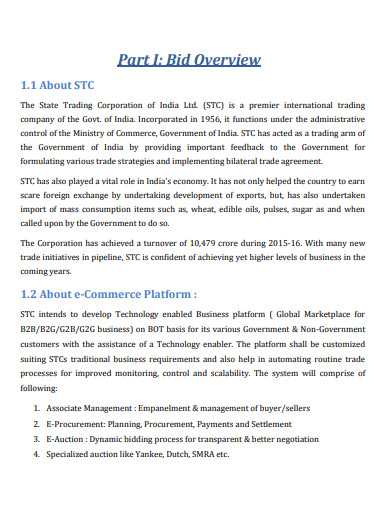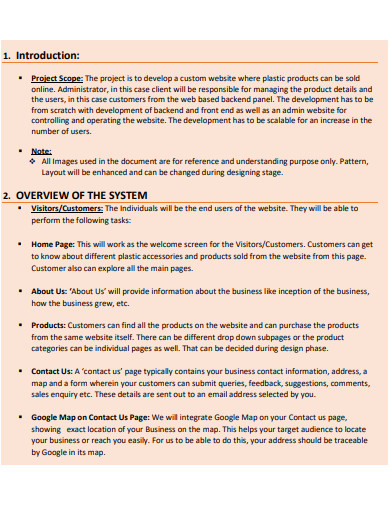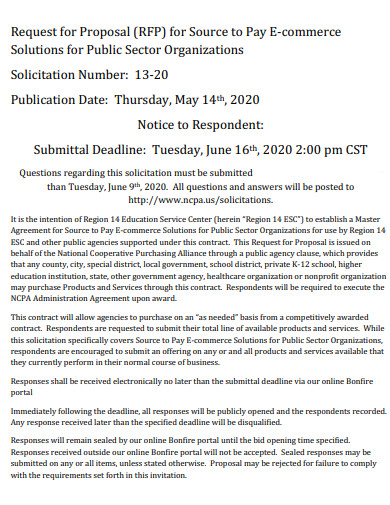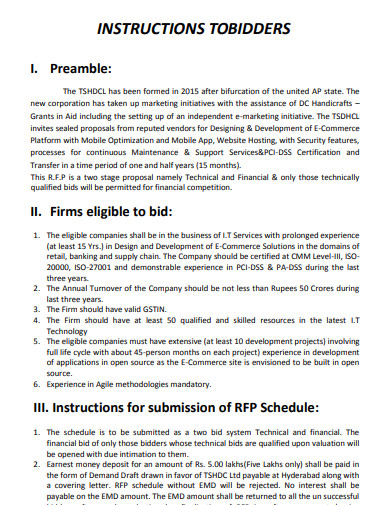This is an example request for proposal (RFP) template that you may download, alter, and compile to meet your specific requirements. It’s an assessment of your nominated vendor’s B2B eCommerce skills or digital commerce attributes. You can either keep your RFP answers as is or publish a new RFP to incorporate their input. You can either proceed on to the negotiation process after receiving all of the proposals, or you can further paring down your sources of supply with more thorough questions. This B2B eCommerce RFP template will be useful for professionals evaluating potential vendors on behalf of the customers, if it’s their initial time starting a B2B eCommerce quality software or upgradable their current site.
4+ E-commerce Request For Proposal Samples
A request for proposal (RFP) is a formal statement that announces the tender process and the first terms of the contract. RFPs can be distributed to the wider populace or to a chosen group of vendors. The purpose of an ecommerce RFP is twofold. To begin, internalize your aims and criteria. Second, codify those goals in a way that allows you to assess and evaluate alternative approaches on your own terms… rather than theirs. You’re obliged to take catch-up or keep afloat with existing traffic, marketing, logistics, inventory, and statistics, rather than concentrating on your product, core strengths, delighting consumers, and boosting revenue through multi-channel and global initiatives.
1. E-commerce Request For Proposal

2. Sample E-commerce Request For Proposal
3. Proposal to Design Ecommerce Website
4. Simple E-commerce Request For Proposal
5. E-commerce Website Design Request For Proposal
How To Write an Ecommerce RFP (13 Steps)
Emphasizing questions and answering the most critical ones first is a fundamental component of this technique. Taking this approach to a new eCommerce project will help establish which solution is vital to the organization, gain corporate buy-in, and have a clear explanation of solution requirements.
Step 1:
Why now, and why a new web page? – The first step is to figure out how important a new eCommerce encounter is to your business and how to measure the situation. What is at risk? Who is affected at a greater extent by this shift, or lack thereof? Why must the eCommerce system and online solutions be rebuilt? Then ask yourself, “Why now?” The answers to these questions must be agreed upon by the executive and management groups.
Step 2:
Name all eCommerce stakeholders – Consider who in the organization will be impacted by this move. You should engage with them to learn how they use your present eCommerce platform and internet business, as well as what they want from the proper approach.
Step 3:
Set aims and outcomes – It’s critical to set 1-5 goals and 5-15 objectives for this venture at this time. The objectives should reach the goals, and the targets should be relevant to the organizational requirements. The executive team and stakeholders must concur on these aims and objectives in order for everyone to be on the same page.
Step 4:
Evaluate the present solution – Inquire about the existing solution’s most important aspects. What works good and should be kept? What doesn’t seem to work? It’s a good idea to try to commercialize each feature on your webpage and rank them according to their value.
Step 5:
Evaluate your competitors and industry – Now is a great time to examine whatever your competitors have been doing and build a list of what you desire. Examine different internet businesses beyond your product category to see what you prefer. Determine whether this will be beneficial to your clients and add it to your wish list.
Step 6:
Draw up a list of all your existing platform’s connections – Talk to your IT peers and come up with a list of all the services that need to integrate to the eCommerce platform (ERP, order management system, inventory system, credit card processing service, tax system shipping services, etc.). Now is also a good time to establish a list of security standards.
Step 7:
Determine your users’ requirements – Users are employees who engage with the website. Commerce teams create products, pricing teams establish prices, production companies create content and graphics, and marketing teams organize promotions are common examples.
Step 8:
Determine your customers’ wants – Who are your ultimate customers? Strive to identify 2-4 categories of customers who purchase from you. Then, speak to these clients to find out what they enjoy and dislike well about website.
Step 9:
Document your important eCommerce features – Now that you’ve gathered all of this data, you can start making a list of the new site’s essential tools and functionalities.
Step 10:
Choose eCommerce functionality – Recognize that you are unlikely to acquire all you desire for your eCommerce platform and online shop. As a result, it’s crucial to divide the characteristics into three different groups of similar significance: critical, major, and important. The inclusion of critical elements on the new site is non-negotiable. Prominent characteristics are those that fit into the next category of adding value proposition to the site but not being vital. Finally, significant features may provide competitive advantages for one or two departments or a few end-users, but not as much on a worldwide scale.
Step 11:
Write the RFP – This should be simple if you followed the previous stages. You can build an organized document that contains all of the information you’ve gathered, beginning with your goals and objectives and moving on to the responsibilities and customers you identified, integration specifics, and highlighted capabilities.
Step 12:
Find suitable development partners – Now is the time to look at different platforms and better procedures. You can then submit out the RFP and get ready to move on with the project.
Step 13:
Select an implementation partner – Compare the statements from the parties to your chosen replies, and then select the partner who best fulfills your demands.
FAQs
What is an E-commerce?
Ecommerce, often known as electronic commerce or online commerce, is the purchasing and selling of goods and services through the internet, as well as the financial and data transfers required to complete these transactions. Ecommerce is most commonly associated with the online selling of tangible goods, but it can also refer to any type of economic transaction enabled by the internet.
What is the use of an RFP?
RFPs are used for large projects that require multiple subcontractors. They identify the organization that is issuing the RFP, the project scope, and the criteria for judging entries. They also explain how to bid and the contract parameters.
If you want to see more samples and formats, check out some e-commerce request for proposal samples and templates provided in the article for your reference.
Related Posts
Title Project Proposal Samples [ Community, School, Student ]
FREE 10+ Health Project Proposal Samples [ Public, Mental, Healthcare ]
FREE 11+ Engineering Project Proposal Samples in PDF | MS Word
FREE 4+ Racing Sponsorship Proposal Samples [ Team, Car, Driver ]
FREE 10+ Nursing Project Proposal Samples [ Community, Health, Clinical ]
FREE 11+ Student Council Proposal Samples in PDF | DOC
FREE 8+ Joint Venture Proposal Samples [ Commercial, Real Estate, Construction ]
FREE 10+ Scholarship Proposal Samples [ Project, Grant, Sponsorship ]
FREE 10+ Network Project Proposal Samples [ Design, Security, Bank ]
FREE 14+ Accounting Proposal Samples in PDF | MS Word
FREE 10+ Church Event Proposal Samples in MS Word | Google Docs | Apple Pages | PDF
FREE 10+ History Proposal Samples [ Dissertation, Thesis, Paper ]
FREE 34+ Sponsorship Proposal Samples in PDF | MS Word | Pages | Google Docs
FREE 11+ Cost Proposal Samples & Templates in PDF
FREE 11+ Maintenance Proposal Samples in MS Word | Google Docs | PDF




